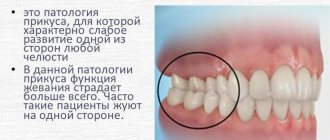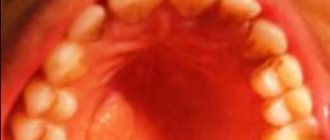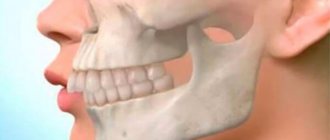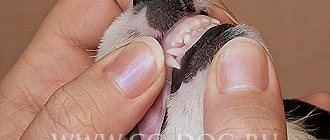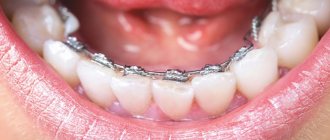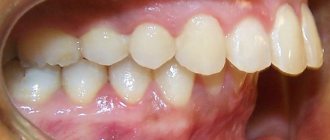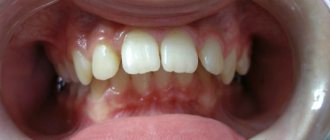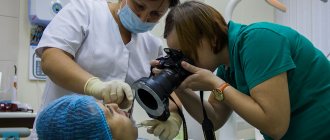Author of the article:
Anastasia Vorontsova
Photo: Lower jaw surgery
Most often, surgical correction of malocclusion is performed in adults.
However, do not be afraid, because... Modern medicine allows surgical intervention to be performed quickly and as painlessly as possible.
Patients who did not undergo bite correction in childhood, when the pathology could be corrected using safer and more loyal methods, can only resort to surgical treatment of the anomaly.
Correcting your bite is not a fad to improve aesthetics.
Surgery to correct the bite is simply necessary, since the anomaly can lead to very serious health problems.
Complications of malocclusion include the following changes:
- Speech impairment.
- Pain in the temporomandibular joint and teeth.
- Increased abrasion of tooth enamel.
- Decay and loss of teeth.
- Diseases of the digestive system due to inadequate chewing of food.
Surgical bite correction is prescribed for adults and is the optimal solution to problems with pathology.
- The operation may also be recommended in childhood in the presence of serious pathology that cannot be corrected with orthodontic treatment.
- In addition, jaw surgery solves the problem of malocclusion much faster than with plates or braces.
Indications
Jaw surgery
is recommended if the following symptoms are present:
Photo: Jaw asymmetry
- The presence of discomfort when biting food.
- With incomplete closure of the lips.
- If speech is impaired.
- When swallowing is impaired: when the tongue ends up between the teeth.
- Anomaly of the dentition associated with a disproportion in the development and growth of the jaw bones.
- The presence of pronounced disturbances in the relationship between the upper and lower jaw.
Indications for surgical correction of bite
The decision about surgery should be made jointly by the doctor and the patient, taking into account all related factors and wishes. Mandatory indications for surgical treatment are:
- distal bite, combined with insufficient formation of the lower jaw or excessively protruded upper jaw;
- non-closure of teeth with frontal or lateral open anomaly of the jaws;
- change in the shape of the face due to a massive lower jaw, dysplasia of the chin, excessively elongated oval of the face;
- pathological closure of teeth, leading to the inability to chew food;
- speech disorders;
- additional teeth outside the dentition;
- jaw injuries, facial injuries causing deformation.
After surgery, it is important to undergo rehabilitation under the supervision of a doctor. The patient wears a bandage for some time, squeezing his cheeks and chin. It is recommended not to open your mouth too much, actively chew food, and blow your nose sharply. It is mandatory to take antibiotics to prevent secondary infection. After two weeks, the sutures securing the elements are removed. After 4 months, the screw structures are removed. All the difficulties of surgical treatment and the rehabilitation period are justified by high cosmetic and functional results.
Progress of the operation
Photo: One of the stages of the operation
- Anesthesia (the operation is performed under general anesthesia).
- Incisions are made in the mouth to free the jaw bones.
- Installation of the jaw bones in the correct position, followed by fixation with screws and plates.
- Finally, a splint is applied to fix the position of the jaws. The splint will need to be worn for approximately two weeks.
It should be taken into account that the progress of the operation depends on the anomaly and the degree of its development.
The duration of the operation is from one to six hours and depends on the number of bones that need correction.
Orthognathic surgery
September 12, 2016
No matter how much we repeat the hackneyed phrase that “one is guided by the mind,” a pleasant appearance, in particular the face, plays a significant role in success in life. What if you were unlucky with your face from birth? Or, God forbid, was it damaged as a result of injury? In many cases of malocclusion and severe disharmony of facial shapes, it is worth turning to maxillofacial correction, and specifically to orthognathic surgery. This relatively young field of medicine, thanks to the latest advances in science and technology, not only restores correct bite and other vital functions of the dental system, but also restores patients’ self-confidence and joy of life. Improvement in appearance, as a rule, pleases even more than comfort and health.
Let's take a closer look at this section of surgery. Moving the upper or lower jaws during surgery, correcting malocclusions and facial shape - this is what orthognathic surgery is all about. This is general information. But in what cases of malocclusion is it worth considering surgical intervention, what are the stages of preparation for the operation, how it happens and how to go through the rehabilitation period without complications - it is better to ask a practitioner about this.
Andrey Nikolaevich Senyuk, a maxillofacial and aesthetic surgeon with more than twenty years of experience, candidate of medical sciences, chief physician and director of the maxillofacial surgery clinic “Face Smile Center,” is ready to answer these and other questions.
Does malocclusion always imply the need for orthognathic surgery?
It depends on the nature of the defect. Malocclusion is distinguished as dentoalveolar and skeletal. And if in the first case the correct relationship of the teeth is corrected by an orthodontist, then only orthognathic surgery can restore the desired relationship of the jaws. This is where the most important stage of treatment begins—the interaction between the orthodontist and the surgeon. Achieving complete success in this process is always the result of a combination treatment. Indications for surgical intervention are: open bite, asymmetry of facial proportions, strongly protruding lower jaw, the so-called gummy smile, pronounced chin slope. This is aesthetics. Physiological disorders include difficulties with chewing food, speech impediment, breathing problems, and the development of chronic pathology of the temporomandibular joint.
Obviously, the type of defect leads to differences in the types of surgical operations?
Yes. There are three main types of orthognathic operations: maxillary osteotomy, mandibular osteotomy and chin osteotomy. In the process of maxillary osteotomy, it becomes possible to move the entire jaw as a single unit. Then it is given the correct position in relation to the lower one. With a mandibular osteotomy, bone cuts are made behind the molars (hence the need to first remove all wisdom teeth) and the jaw is set in the desired position. To secure the jaws, special plates made of medical titanium are used. Osteotomy of the chin is part of a set of measures for surgical correction of the chin in order to improve its aesthetic appearance.
What do you need to know before deciding to undergo orthognathic surgery?
First of all, you need to clearly understand that this process is very slow, since orthodontic preparation for surgery alone can take about a year. All this time the patient wears a brace system. This is the specificity of the treatment. In addition, wisdom teeth must first be removed, because... The saw line of the jaw usually falls on these places. Further. Orthognathic surgery can only be performed upon reaching the age of 18, when active skeletal growth ceases. Statistically, an age group of 20 and 30 years can be distinguished. It is at this age that formed self-awareness and an adequate approach to the treatment process are most characteristic. Finally, individual response to anesthesia is also taken into account when deciding whether to undergo orthognathic surgery.
Are there any peculiarities in the preoperative period?
After orthodontic preparation, the patient moves to the surgeon's group. Here, too, a number of manipulations are required: facial anthropometry taking into account individual parameters, computed tomography and its analysis, planning the necessary movements of the jaws in a special program. Before the operation itself, several conditions must be met: stopping food intake 12 hours before the appointed time, including water; it is strictly forbidden to perform the operation in case of illness: a cold or even just a fever, as well as problems with digestion. In this case, the operation is postponed until complete recovery. If the patient is routinely taking any medications, the doctor should be aware, since some of them may be incompatible with anesthesia or affect blood clotting.
How is the operation performed?
The operation itself lasts from 1 to 6 hours, depending on the volume and complexity of the surgical intervention. There are no reserves left on the facial tissues outside, because... All surgical procedures are performed in the oral cavity. To fix the displaced jaw, plates made of special medical titanium are used. The wounds are then sutured. From this moment, an equally important rehabilitation period begins.
What symptoms of the postoperative period are considered normal?
Unfortunately, it is not possible to avoid a number of unpleasant but inevitable symptoms after such an operation, such as: temporary swelling and bruising in the cheeks and lips, nausea, sore throat, nasal congestion, difficulties with proper oral hygiene, and minor weight loss.
What are the possible complications with such operations?
I want to say that if all stages of orthognathic surgery are carried out correctly, then complications occur extremely rarely. However, when performing an osteotomy of the lower jaw, due to its anatomical structure, a decrease in the sensitivity function of the ternary nerve is possible. This manifests itself in the form of partial numbness in the area of the lower lip and has practically no effect on facial expressions. Complications such as bleeding and inflammation depend on the individual characteristics of the body and on compliance with the doctor’s recommendations.
How long does the rehabilitation period generally last?
The early stage of rehabilitation lasts 3 weeks, after which the patient returns to his professional activities. Further restoration of the body is the work of the body itself. This implies a gentle regimen of exercise, both physical and vitamins and physiotherapy.
Rehabilitation
The recovery period after surgery is quite long and difficult.
- To prevent infection, a course of antibiotics is prescribed from the first days after surgery.
- Immediately after the operation, a pressure bandage is applied to the cheeks and chin for one day.
- While wearing the splint, it is not recommended to chew, blow your nose, or open your mouth wide.
- While wearing elastic bands, the dentist monitors their position, as well as the state of the bite.
- On the tenth to fourteenth day, the sutures are removed.
- After the sutures are removed, the elastic bands are installed on the braces.
- After about three to four months, the screws from the jaws are removed.
Results of the operation
Orthognastic surgery can transform a person's appearance. Improving facial features helps him look younger and more attractive. This is necessary because the standard of beauty is symmetrical face shapes. Besides, a beautiful smile also attracts people. And a person with an irregularly shaped jaw is often simply embarrassed to smile, becomes withdrawn and loses self-confidence.
From various photos you can see what results orthognathic surgery can help achieve. Before and after surgery, the patient often looks completely different. She can lengthen the jaw or make it shorter, change its position, change the shape and size of the chin. Due to this, facial features become more correct and appearance is transformed. The positive effect of the operation is also explained by the fact that all incisions are made from the inside, so the integrity of the external tissues is not compromised.
In addition to obtaining an aesthetic result, such an operation helps to get rid of functional disorders, for example, blurred speech and difficulty chewing functions. Most importantly, orthognastic surgery improves the patient’s psychological state and increases his self-confidence.
Price
Surgical correction of malocclusion is a fairly expensive service, which includes prices for:
- Preoperative examination and preparation of the patient for surgery.
- Cost of anesthesia and necessary medications.
- Carrying out the operation.
- Consumables.
- Observation and consultation of the patient in the postoperative period.
The total cost of the service can range from 300 to 450 thousand rubles.
What problems does orthodontic surgery solve?
An orthodontist cannot always correct malocclusion pathology only with the help of a brace system. For example, when the incorrect position of the teeth is accompanied by asymmetry of the skeletal frame or incorrect jaw relationship. In some cases, it is possible to carry out a compromise treatment without resorting to surgery, but it will not change the patient’s appearance for the better, and the results of the correction may be unstable.
Orthognathic surgery helps to solve the problem comprehensively - correcting the size, position and relationship of the jaws. Before prescribing an operation, the orthodontist and the maxillofacial surgeon jointly conduct a diagnosis, develop a plan for future treatment, and select the most appropriate correction methods to be used after surgery.
When working, specialists use special computer programs that not only help plan treatment, but also allow you to visualize the result. Even before all manipulations begin, the patient will be able to see how his face will change after the operation.
Reviews
- A year ago, I surgically corrected an open bite, since at the age of 36, orthodontic treatment turned out to be powerless. For a long time I could not decide to have the operation. Passed the necessary examination. The anomaly was corrected under general anesthesia. The operation lasted four and a half hours, then I walked with splints for a very long time until everything healed. Postoperative swelling lasted for almost a month, but completely disappeared after two months. During this time, I lost almost six kilograms in weight.
- As a child, I refused to correct my malocclusion using braces. Two years ago I decided to have my bite corrected surgically. The operation was successful and lasted about three hours. The rehabilitation period lasted almost two months. I was pleased with the results.
